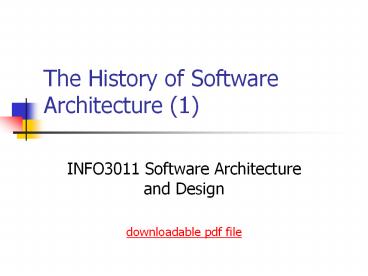The History of Software Architecture 1 - PowerPoint PPT Presentation
1 / 11
Title:
The History of Software Architecture 1
Description:
Architectural styles. Style and engineering. Style and ... Prescribe the architectural constraints to the desired level. Separate aesthetics from engineering ... – PowerPoint PPT presentation
Number of Views:388
Avg rating:3.0/5.0
Title: The History of Software Architecture 1
1
The History of Software Architecture (1)
- INFO3011 Software Architecture and Design
- downloadable pdf file
2
Leading Contributors
- The leading contributors of the modern discipline
of Software Architecture to date are - Dewayne Perry and Alexander Wolf
- Mary Shaw and David Garlan
- Len Bass, Paul Clements, Rick Kazman and Linda
Northrup - Frank Buschmann et al.,
- James O. Coplien
3
Foundations of Study
- The seminal work is a 1992 paper by Dewayne E.
Perry and Alexander L. Wolf - Foundations for the Study of Software
Architecture. ACM SIGSOFT Software Engineering
Notes 17(4) pp.40-52 - Constructed a model of Software Architecture
consisting of 3 components - Elements
- Form
- Rationale
4
Perry and Wolf, 1992
- We use the term architecture rather than
design to evoke notions of codification, of
abstraction, of formal training (of software
architects), and of style - Benefits sought
- Architecture as a framework for satisfying
requirements - Architecture as the technical basis for design
- Architecture as an effective basis for reuse
- Architecture as the basis for dependency and
consistency analysis
5
Basis of the Intuition
- Perry and Wolf examined other architectural
disciplines for lessons - Computing hardware architecture
- Small number of design features
- Scale achieved by replication of the design
elements - Network architecture
- Two kinds of components nodes and connections
- Only a few topologies to be considered
- Building architecture
- Multiple views
- Architectural styles
- Style and engineering
- Style and materials
6
The Context of Architecture
- Requirements are concerned with the determination
of the information, processing and
characteristics of that information needed by the
user of the system - Architecture is concerned with the selection of
architectural elements, their interactions, and
the constraints on those elements and their
interactions necessary to provide a framework in
which to satisfy the requirements and serve as a
basis for design - Design is concerned with the modularisation and
detailed interfaces of the design elements, their
algorithms and procedures, and the data types
needed to support the architecture and to satisfy
the requirements and - Implementation is concerned with the
representations of the algorithms and data types
that satisfy the design, architecture and
requirements.
7
The Purpose of Architectural Specification
- Architectural specifications are required to be
of such a character that we can - Prescribe the architectural constraints to the
desired level - Separate aesthetics from engineering
- Express different aspects of architecture in an
appropriate manner - Perform dependency and consistency analysis
8
The Model elements
- Software Architecture elements, form,
rationale - Elements
- Processing elements
- Data elements
- Connecting elements
9
The Model form
- Form
- Consists of weighted properties and relationships
- Weighting is either
- Importance of property or relationship
- Or necessity of selecting among alternatives
- Properties
- Define the minimum constraints on the choice of
architectural elements - Relationships
- used to constrain the placement of
architectural elements and how they interact
10
The Model rationale
- Rationale
- Is underlying, but integral
- Captures the motivation for the choice of style,
elements and form - In building architecture
- Rationale explicates underlying philosophical
aesthetics - In software architecture
- Instead explicates the satisfaction of system
constraints - Functional and non-functional
11
Architectural Style
- Perry and Wolf noted that, distinct from other
architectural disciplines, software architecture
had no named styles - They proposed that architectural styles be used
as constraints on an architecture - The important thing about an architectural style
is that it encapsulates important decisions about
the architectural elements and emphasizes
important constraints on their elements and their
relationships































